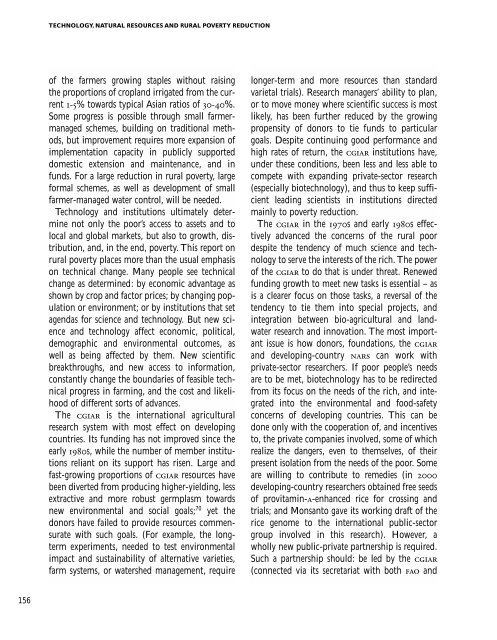English - IFAD
English - IFAD
English - IFAD
Create successful ePaper yourself
Turn your PDF publications into a flip-book with our unique Google optimized e-Paper software.
TECHNOLOGY, NATURAL RESOURCES AND RURAL POVERTY REDUCTION<br />
of the farmers growing staples without raising<br />
the proportions of cropland irrigated from the current<br />
1-5% towards typical Asian ratios of 30-40%.<br />
Some progress is possible through small farmermanaged<br />
schemes, building on traditional methods,<br />
but improvement requires more expansion of<br />
implementation capacity in publicly supported<br />
domestic extension and maintenance, and in<br />
funds. For a large reduction in rural poverty, large<br />
formal schemes, as well as development of small<br />
farmer-managed water control, will be needed.<br />
Technology and institutions ultimately determine<br />
not only the poor’s access to assets and to<br />
local and global markets, but also to growth, distribution,<br />
and, in the end, poverty. This report on<br />
rural poverty places more than the usual emphasis<br />
on technical change. Many people see technical<br />
change as determined: by economic advantage as<br />
shown by crop and factor prices; by changing population<br />
or environment; or by institutions that set<br />
agendas for science and technology. But new science<br />
and technology affect economic, political,<br />
demographic and environmental outcomes, as<br />
well as being affected by them. New scientific<br />
breakthroughs, and new access to information,<br />
constantly change the boundaries of feasible technical<br />
progress in farming, and the cost and likelihood<br />
of different sorts of advances.<br />
The CGIAR is the international agricultural<br />
research system with most effect on developing<br />
countries. Its funding has not improved since the<br />
early 1980s, while the number of member institutions<br />
reliant on its support has risen. Large and<br />
fast-growing proportions of CGIAR resources have<br />
been diverted from producing higher-yielding, less<br />
extractive and more robust germplasm towards<br />
new environmental and social goals; 70 yet the<br />
donors have failed to provide resources commensurate<br />
with such goals. (For example, the longterm<br />
experiments, needed to test environmental<br />
impact and sustainability of alternative varieties,<br />
farm systems, or watershed management, require<br />
longer-term and more resources than standard<br />
varietal trials). Research managers’ ability to plan,<br />
or to move money where scientific success is most<br />
likely, has been further reduced by the growing<br />
propensity of donors to tie funds to particular<br />
goals. Despite continuing good performance and<br />
high rates of return, the CGIAR institutions have,<br />
under these conditions, been less and less able to<br />
compete with expanding private-sector research<br />
(especially biotechnology), and thus to keep sufficient<br />
leading scientists in institutions directed<br />
mainly to poverty reduction.<br />
The CGIAR in the 1970s and early 1980s effectively<br />
advanced the concerns of the rural poor<br />
despite the tendency of much science and technology<br />
to serve the interests of the rich. The power<br />
of the CGIAR to do that is under threat. Renewed<br />
funding growth to meet new tasks is essential – as<br />
is a clearer focus on those tasks, a reversal of the<br />
tendency to tie them into special projects, and<br />
integration between bio-agricultural and landwater<br />
research and innovation. The most important<br />
issue is how donors, foundations, the CGIAR<br />
and developing-country NARS can work with<br />
private-sector researchers. If poor people’s needs<br />
are to be met, biotechnology has to be redirected<br />
from its focus on the needs of the rich, and integrated<br />
into the environmental and food-safety<br />
concerns of developing countries. This can be<br />
done only with the cooperation of, and incentives<br />
to, the private companies involved, some of which<br />
realize the dangers, even to themselves, of their<br />
present isolation from the needs of the poor. Some<br />
are willing to contribute to remedies (in 2000<br />
developing-country researchers obtained free seeds<br />
of provitamin-A-enhanced rice for crossing and<br />
trials; and Monsanto gave its working draft of the<br />
rice genome to the international public-sector<br />
group involved in this research). However, a<br />
wholly new public-private partnership is required.<br />
Such a partnership should: be led by the CGIAR<br />
(connected via its secretariat with both FAO and<br />
156
















